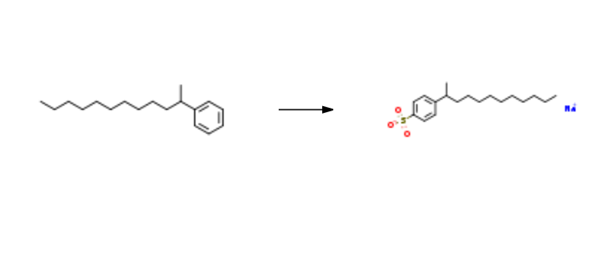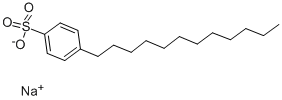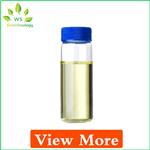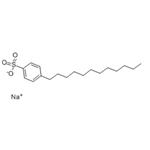Description
Sodium dodecyl benzene sulfonate is a series of organic compounds with the formula C12H25C6H4SO3Na. It is a colourless salt with useful properties as a surfactant. It is usually produced as a mixture of related sulfonates. It is a major component of laundry detergent.
Chemical Properties
white or light yellow flakes
Uses
Sodium dodecylbenzenesulfonate has been used to stabilize dispersions of graphene nanoflakes (GNFs) during the preparation of the liquid phase of GNFs. It can also suspend single-walled carbon nanotubes as individuals in aqueous media and also give well-resolved spectral features.
Uses
A surfactant used in proteomics research.
General Description
Sodium dodecylbenzenesulfonate is a white to light yellow flakes, granules or powder. Sodium dodecylbenzenesulphonate is soluble in water. The primary hazard is the threat to the environment. Immediate steps should be taken to limit its spread to the environment. Sodium dodecylbenzenesulphonate is used as a synthetic detergent.
Air & Water Reactions
Sodium dodecylbenzenesulphonate is soluble in water.
Reactivity Profile
SODIUM DODECYLBENZENESULFONATE is incompatible with strong oxidizers.
Health Hazard
Minor skin and eye irritant. INGESTION: May cause vomiting, diarrhea, and intestinal distension.
Flammability and Explosibility
Non flammable
Industrial uses
These frothers are mixtures of alcohols containing 6–8 carbon atoms. They were at one
time marketed by DuPont and they are tailored frothers for specific ore types. The bestknown
frother from this group is methyl isobutyl carbinol (MIBC) and 2-ethyl hexanol.
Aliphatic alcohol frothers are used as mixtures of different carbon lengths and as a
mixture of hydrocarbon oils.
Safety Profile
Poison by intravenous
route. Moderately toxic by ingestion. A skin and
severe eye irritant. When heated to decomposiuon
it emits tomc fumes of NazO. See also
SULFONATES
Synthesis
Sodium dodecylbenzenesulphonate is synthesised using 2-phenyldodecane as raw material by chemical reaction. The specific synthesis steps are as follows:
To a 5 L round bottom flask equipped with mechanical stirrer and an addition funnel was added octadecane and 2-phenyldodecane mixture ( 1.73 kg, 28%> 2-phenyldodecane). The reaction mixture was sparged with argon, warmed to 35°C and 1.25 weight % of oleum (632 g, 1.58 mol) was added dropwise, via addition funnel, to reaction mixture. The reaction mixture was stirred for 1.5 hours at room temperature. Upon completion, the reaction mixture was heated to 50°C and transferred to a separatory funnel and allowed to separate. The bottom layer was added slowly to a stirred solution of 15%> NaOH (aq) (2 L) at 10°C. Upon complete addition the resulting suspension was stirred for an additional 60 minutes. The solid was subsequently isolated by filtration and washed twice with ice-cold water. The solids were air dried for 16 hours and vacuum dried at 80°C to yield sodium, 4-(dodecan-2-yl) benzenesulfonate (555 g, 80.8% yield, 98.5% purity). lH NMR (400 MHz, (CD3)2S0/CDC13) δ 0.84 (t, J = 7.0 Hz, 3H), 0.95- 1.38 (m, 19H), 1.51 (pquart, J = 7.3 Hz, 2H), 2.65 (psext, J = 7.0 Hz, 1 H), 7.1 1 (d, J = 7.6 Hz, 2H), 7.56 (d, J = 8.4 Hz, 2H). 13C NMR (101 MHz, (CD3)2S0/CDC13) δ 13.8, 22.0, 22.1 , 27.0, 28.9, 28.9, 28.9, 28.9, 31.2, 37.6, 38.8, 125.4, 125.8, 145.3, 147.7.

Purification Methods
It crystallises from propan-2-ol or H2O. [Gray et al. J Org Chem 20 515 1955, Beilstein 11 IV 514.]
Environmental considerations
Biodegradability has been well studied , and is affected by the isomerization (branching). The salt has an LD
50 of 2.3 mg / liter for fish , about 4x more toxic than the branched tetra propylene benzene sulfonate. It is however biodegraded more rapidly. Oxidative degradation initiates at the alkyl chain.
Alkyl benzene sulfonates
Most sodium dodecyl benzene sulfonates are a member of the linear alkyl benzene sulfonates, meaning that the dodecyl group (C
12H
25) is un branched. This dodecyl chain is attached at the 4- position of the benzene sulfonate group. Linear dodecyl-4-benzene sulfonate anions can exist in six isomers (ignoring optical isomers), depending on the carbon of the dodecyl group that is attached to the benzene ring. The isomer shown below left is 4-(5-dodecyl ) benzene sulfonate (4 indicating the position of the benzene ring, 5 indicating the position on the dodecane chain). Branched isomers, e.g. those derived from tetramerized propylene, are also known (below right) but are not as widely used because they biodegrade too slowly.
Production Trillions of kilograms are produced annually. Given the large scale of the application, the alkyl benzene sulfonates have been prepared by many methods. In the most common route, benzene is alkylated by long chain mono alkenes (e.g. dodecene) using hydrogen fluoride as a catalyst. The purified dodecyl benzenes (and related derivatives) are then sulfonated with sulfur trioxide to give the sulfonic acid. The sulfonic acid is subsequently neutralized with sodium hydroxide.





